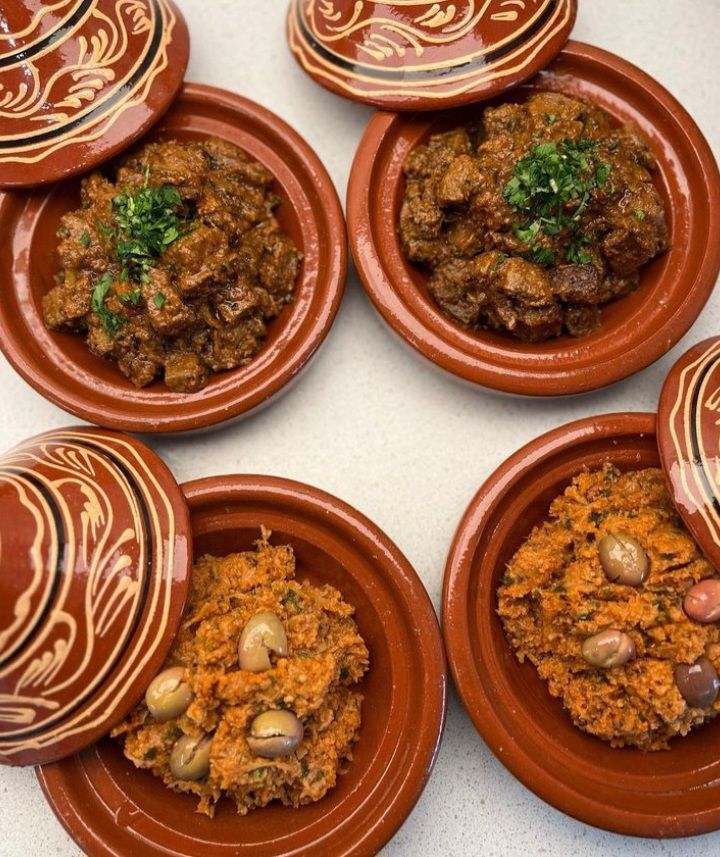Tagine is one of those dishes that seems to define Moroccan cuisine, but it’s actually bigger than Morocco. You’ll find versions of tagine all over North Africa, from Algeria and Tunisia to Libya. In each place, the dish has evolved slightly, influenced by local ingredients and culinary traditions.
The big question, though: is tagine really that good? Well, that depends. At its best, it’s an incredibly flavorful slow-cooked stew, rich with spices and depth. But it can also be pretty hit-or-miss—especially in tourist-heavy areas where watered-down versions dominate. If you know where to look, though, you can find tagine that actually lives up to the hype.
So, what exactly is tagine? Where can you get the real deal? And if you can’t, is it worth making at home? Let’s break it down.
What is Tagine?
Tagine is both a dish and a cooking vessel. The pot itself is made of clay, with a wide base and a conical lid that traps steam, keeping everything moist while intensifying flavors. It’s a slow-cooking process, and the end result is usually fall-apart tender meat or vegetables infused with spices, aromatics, and sometimes dried fruits or nuts.
But here’s where it gets interesting—while most people associate tagine with Morocco, the dish isn’t limited to one country. North African cuisine is deeply interconnected, and tagine (or at least similar slow-cooked stews) exists across the region.


Tagine Variations Across North Africa
Morocco – The Tourist-Friendly Classic
In Morocco, tagine is everywhere. The most common versions include:
- Lamb Tagine with Prunes – A rich, slightly sweet stew where the lamb is slow-cooked with prunes, almonds, and cinnamon.
- Chicken Tagine with Preserved Lemon and Olives – Salty, tangy, and one of the most balanced versions.
- Kefta (Meatball) Tagine – Small spiced meatballs in a tomato-based sauce, often with an egg poached on top.
Moroccan tagine is often heavily spiced but not overly spicy. It leans into the sweet-savory contrast, especially in fancier restaurants that cater to tourists. Some versions are incredible, while others can feel a bit safe—cooked to please the masses rather than showcasing real, bold flavors.



Algeria – Heartier and More Rustic
Algerian tagine tends to be heartier, with a stronger focus on chickpeas, vegetables, and regional spices. One common version is Tagine Zitoune, which features chicken or lamb cooked with olives and a thick, often tomato-based sauce. Unlike the Moroccan versions, Algerian tagines are often served with bread instead of couscous, making them feel more like a rich, spiced stew.
Tunisia – Spicier and More Unique
Tunisia does tagine completely differently. Here, “tagine” refers to something closer to a frittata—a baked egg dish with layers of meat, cheese, and potatoes. It’s more of a casserole than a stew. If you’re looking for slow-cooked, Moroccan-style tagine in Tunisia, you’ll find it, but it’s usually referred to as Maraq instead. Tunisian versions are often spicier, thanks to the heavy use of harissa, the famous North African chili paste.
Libya – Underrated and Incredible
If you want one of the best, most underrated versions of tagine, Libya is the place to go. Libyan tagine is richer, often cooked in a deep tomato sauce with stronger spices. Unlike Moroccan tagine, which leans into sweetness, Libyan tagine is all about bold, savory flavors. It’s also usually served with bazeen, a traditional doughy bread that soaks up the sauce beautifully.
I have to say that I felt Libyan food to be a bit of a gem, particularly the tangines here.
Click to read about the best Libyan Drinks.
Is It Worth Making at Home?
If you can’t find a good tagine near you, making it at home is a solid option. You don’t even need a traditional tagine pot—any heavy, lidded pot like a Dutch oven will do. The key is slow cooking, patience, and using good spices.



Here’s a simple Chicken Tagine with Preserved Lemon and Olives recipe you can try:
Ingredients:
- 4 bone-in chicken thighs
- 2 preserved lemons, quartered
- 1 cup green olives
- 1 large onion, chopped
- 3 cloves garlic, minced
- 1 tsp ground cumin
- 1 tsp ground ginger
- 1 tsp paprika
- ½ tsp cinnamon
- ½ tsp black pepper
- 1 pinch saffron (optional)
- 2 cups chicken broth
- 2 tbsp olive oil
- Fresh cilantro or parsley for garnish
Instructions:
- Heat olive oil in a large pot or tagine over medium heat. Add the onions and garlic, cooking until softened.
- Add the chicken thighs, skin side down, and brown them slightly.
- Sprinkle in the spices and mix well.
- Pour in the chicken broth and add the preserved lemons and olives.
- Cover and let simmer on low heat for about 1.5 hours, until the chicken is tender.
- Garnish with fresh cilantro or parsley before serving.
Serve it with warm bread or couscous to soak up the sauce, see even I can cook up a storm!

Photo: Snap Foodie
Final Verdict – Is Tagine Worth the Hype?
Tagine is one of those dishes that can be either incredible or completely forgettable, depending on where you get it. Moroccan tagine is the most famous, but Libyan and Algerian versions often have even richer flavors. If you’re in North Africa, it’s worth seeking out the real deal—just avoid the overly touristy spots. If you’re not, either find a solid Moroccan restaurant or make it at home.
Would I go out of my way just for tagine? Maybe not. But when it’s done right, it’s definitely worth your time and effort.

